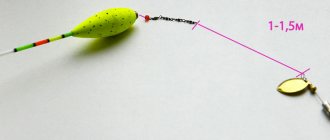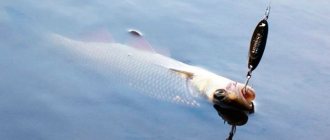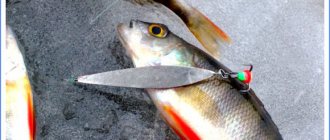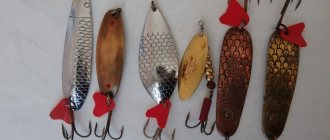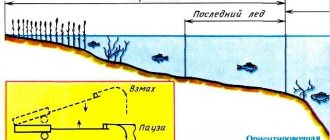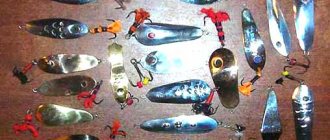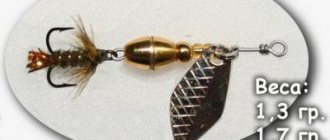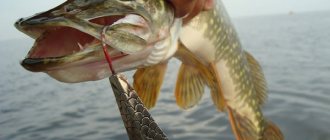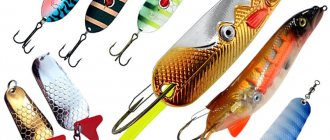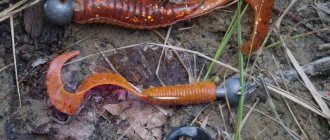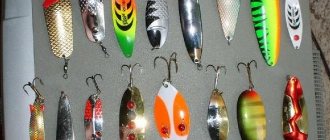There are many fishing methods, but in order to catch predatory fish, bait such as a spinner is used. You can fish with it on any body of water, including those where the water may be cloudy or dark.
This method has found great popularity among fishermen, and if we talk about its appearance, then it is a very old method that appeared more than 1000 years ago. The advantages of fishing in this way include the opportunity to catch large predators, such as pike, perch, catfish, and other predatory species, which are valued among professional fishermen.
Spinner as bait
Before you opt for catching predators with a lure, you need to know that it is designed to imitate fish, so only predators that are found in the body of water where the fisherman has arrived will bite.
Carnivorous breeds include the following:
- Pike.
- Perch.
- Zander.
- Chub.
- Salmon and some other types of fish that are found in certain areas and bodies of water.
But the most common ones, which are common in our reservoirs, are, of course, pike and perch. They are found almost everywhere, both in small bets and large reservoirs and rivers, so the choice of spinner is also of particular importance.
If we talk about the seasons, it can be noted that this method can be used at all times of the year, without paying attention to the thermometer readings, but one feature should be noted. In winter, it is best to catch perch using a spoon.
As you know, gear for winter fishing is specific, so the bait itself (spoon) will need to be selected taking into account the limited diameter of the hole and the method of moving the fishing rod (up and down), otherwise there will be no difference. In order to understand the effectiveness of using such bait, you need to know how predators hunt and what they prefer. For example, perch mostly feeds on small river crustaceans or small fish, so it will never bite on large bait.
Pike, on the contrary, eats many types of freshwater inhabitants, and in size can reach more than 35 kilograms of weight. From this comes the essence of using spinners, which come in different types. When she plunges into the water, her main task is to attract the attention of a predator and make her want to swallow, thinking that this is a desired prey.
But it doesn’t have to be, the spoon should resemble a small fish, it should, while in the water, imitate the movement of potential victims hunted by predators, and at the same time not arouse suspicion. A special type of coloring allows the predator to appear that the prey is damaged and is bleeding, or to be conspicuous to the predator. That is, its main task is to make the predator believe that there is another victim in front of him and swallow it.
After it is swallowed, the peculiar hooks will no longer allow the predator to jump off the bait, and the fisherman will be able to get the fish ashore.
If we talk about how to fish with a spoon, it should be noted that this method is used in two versions:
- From the shore of the reservoir.
- From the boat.
In the first case, two factors need to be taken into account:
- Casting distance of the spinner.
- The presence of depth and predators in the casting area.
That is, if the reservoir is large, and its depth, or the fish habitats are located at a considerable distance from the shore, then fishing in this way may not bring the expected success.
Here, of course, you will need either the ability to throw very far, or a boat. If, on the contrary, everything is nearby, and the depth is suitable, then fishing from the shore is just right. Speaking about lure fishing from a boat, you also need to take into account that when you approach a certain place, you need to wait a little, since the extra noise of the engine or oars can scare off the river inhabitants for a while, and they may not be around.
As for the rest, lure fishing does not create certain conditions for fishermen, and there are dilemmas about what is the best way to cast. The main thing is skill, good gear and patience.
Lure fishing
A complete description of lure fishing is quite often found in numerous literature on fishing. Therefore, we will touch only on certain aspects of this type of sport fishing.
Fishing with a spinning rod requires a certain amount of physical endurance from the angler, not only because of the numerous casts, but also because of long journeys along the banks of the reservoir, sometimes with overcoming hard-to-reach areas - ravines, wetlands and overgrown areas. In this case, as a rule, all the fisherman’s luggage remains behind his back in his backpack, which further increases physical activity.
The most favorable time for lure fishing is autumn, especially September, the period of the so-called “Indian summer”, on warm, quiet, cloudy or sunny days, when the leaves on the trees begin to turn yellow and cobwebs fly in the air.
On hot summer days, even in the morning dawns, it is hardly advisable to engage in lure fishing: the water is still not very clear, there are a lot of small fish swimming in it, and predators are well-fed enough to be tempted by artificial bait.
It’s a different matter in the fall, when on the eve of winter the fish begin to feed intensively, the water becomes transparent, aquatic vegetation falls to the bottom, creating good visibility for the predator, and small fish reduce their activity, no longer hiding at the bottom. Then the skillful guiding of a correctly selected spoon will undoubtedly be noticed by a predator and its grip will occur.
Casting a spinner
Casting a spoon After each cast, it is necessary to inspect the spoon and remove everything that has stuck to it when accidentally touching the bottom - grass, leaves, etc., since even small blades of grass on the spoon worsen its performance in the water.
When fishing with a spinning rod in the current, it is advisable to shift the radial (fan) casting system towards the current, that is, when casting against the current, the angle of inclination to the shoreline during the first cast should be at least 45°, and along the current - up to a cast almost parallel to the shore. In this case, when casting against the current, you should reduce the countdown of seconds for immersing the spoon to a minimum and increase the speed of the retrieve and, conversely, when casting with the current, slow down the rotation of the reel when winding up the fishing line, sometimes even stopping it if the spoon comes out close to the surface of the water. Usually, in places with fast currents, the depth of the river is small, and it is necessary, by varying the speed of rewinding the fishing line, to ensure that the spoon is still located near the bottom or in the middle layers of the water. The current of the river, as a rule, is stronger towards its middle, and the spoon is carried downstream, and the fishing line takes on an arched position, which complicates the reliability of the hook when a predator grabs the spoon. Therefore, the hook in these cases should be wide and strong, which is achieved by the appropriate span of the spinning rod.
Casting is especially effective and efficient in places where shallow water (rifts) transition to a deeper section of the river, where the bottom ledges into the depths and a strong current is formed. Predators love to hunt here, waiting for small fish to be carried away by the current. Having made a cast to the riffle, above the transition to a deep place, they reel in the spinner, carried by the current, near the ledges of the bottom, slowing down the reeling of the fishing line as the spinner moves to deep places. The grip of a predator is well determined by the spinner by the sudden stop of the fishing line and is felt like a dull blow, and sometimes even the handles of the reel jump out of the hand. When stopping the line like this, you should make a sharp, short hook with the rod. After one or two seconds, usually the fish will pull the line towards itself with reciprocal pushes, which absolutely indicates that the predator, as fishermen say, has “sat on the lure.” To be sure, it is advisable to repeat a short, energetic hook, since during the first hook, the line was not straight enough and some of its sag softened the hook, and the hook of the spoon could not fit securely into the mouth of the fish.
A few more tips for casting a spoon from an inconvenient place. If there are bushes on the bank to the right and left that do not allow you to make a regular side cast, you can cast over your head. At the same time, when sending the spinner, you must remove your finger from the reel drum exactly at the right moment, otherwise the spinner will fall nearby near the shore. Typically, a spinning player easily masters this method after several exercises on a free section of the shore. However, it is difficult to cast long-distance spinners using this method, and therefore, if the situation allows, you can cast in this place of the reservoir by climbing higher up the steep bank and sending the spoon over the bushes with a regular side cast. Then, starting the reverse winding, go down again to the coastal edge. Naturally, in the process of approaching the water, the fishing line should be reeled in a little faster in order to prevent it from sagging and the lure from lying on the bottom.
Posting the spinner
Spinner wiring diagram The wiring speed for each spinner is determined visually near the coastal zone, when the angler can observe the play of the spinner as it is retrieved.
The general rules for placing a spinner, except for catching asp on the Devon, provide for placing it near the bottom of the reservoir, but not along the bottom. By changing the reeling speed, speeding it up when the spoon touches the bottom, which is easily felt by the angler on the fishing line, and even sometimes stopping the reeling for 1-2 seconds, you can imitate the behavior of a fish and increase the chances of a predator grabbing the spoon.
Sometimes it is useful to guide the spinner with ledges, stopping reeling for 1-2 seconds, and then, slightly raising the top of the rod, continue reeling the line again. In this case, the spoon, first rising from the bottom and then falling again, imitates the swimming of live bait, which increases the chances of being caught by a predator. If there are no bites after one or two casts of the spoon, you should not immediately change the place and move on to another. If the place looks good, which the angler can determine by the external signs of fish habitat, he should repeat casts in a fan pattern, that is, sending the spoon from one place at different angles to the coastline, as well as changing the depth and nature of the spinner's movement. If a place allows, for example, a prominent coastal cape, from which it is convenient to cast, you should make such a cast along the coastline, at a distance of 5-10 m from it, trying not to catch the bottom of the spoon when reeling. Thus, the radial casting system expands significantly, which, as a rule, brings success.
Fishing
Based on the resistance of the fish, you can determine its approximate size and begin fishing for it accordingly. A thicker line when fishing with a spoon than when fishing with live bait allows you to pull the prey to the shore without much hassle and drag it through the coastal vegetation to the shore.
The fact is that when fishing with a spinning rod, the angler does not have an eyeliner, and using a short hook from the shore is not always possible. If the prey is very large, and the spinner is wearing high waders, it is advisable, after fishing and the fish is sufficiently tired, to bring it to the very shore and, entering the water, take the prey from above near the head and throw it ashore in one motion.
Gatherings of predators during fishing can occur for a number of reasons: the tee of the spoon is not sharp enough (or previously bent when hooked), dangerous jerks of the fish with an excessively stretched line, especially pike “candles”, and most often, inept pulling of the prey ashore, when the weight of the The fish are accompanied by sharp jerks on a short line. Catching a fish that has fallen off a hook in the water with your hands is a useless exercise, and the fisherman is left with grief to scold himself for his hasty actions. We repeat once again, you should never grab the fishing line with your hands when pulling fish ashore - this almost always leads to loss of prey!
Sometimes, when reeling in the spinner and suddenly stopping the line, followed by hooking the expected prey, the spinner does not feel the response jerks of the fish; the line continues to be taut. In this case, most likely the lure got caught on underwater snags. Still, you should repeat the hook and observe the position of the fishing line. Sometimes a very large pike that takes a spoon does not show any signs of life for the first few seconds, and only the movement of the fishing line against the current and its increasing tension shows that this is not a hook, but the grip of a predator.
Choosing a spinner
The choice of spoons must be approached very carefully and with knowledge of this type of fishing. First of all, you need to dwell on the types of spinners:
Spoons. The essence of this type is that the bait is shaped like a spoon without a handle. When it is immersed in water, it creates fluttering movements and makes the predator think that it is an injured prey.
Particularly effective is a spoon that is colored in the form of red stripes (red devil); for a predator, this is an association with streams of flowing blood, and an additional incentive to swallow it.
Jig. This type of bait has a special design, which is made in the form of a fish’s head and a tail, which is made of feathers or plastic.
When it gets into the water, it behaves like a real river creature that is hunted by predators, and its hook is hidden in the tail, and you can also attach live bait to it. This is one of the most common types of spinners among fishermen.
A spoon with a certain diving depth. This type is used mainly for catching perches, and its essence is that it is made mainly of wood or plastic. Two hooks are attached to it, which, depending on the weight, are lowered to a certain depth at which the perch hunts.
Thanks to its special shape, the bait depicts a sick or damaged fish with its movements, and forces the perch to start hunting and swallow it. It is also popular among those who want to catch perch.
Strand. This type of bait combines the advantages of a spoon and sick fish, which were described above. They are connected to each other by a metal plate in the form of a blade, which begins to create rotational movements in the water, making noise. A predator can mistake it for a sick victim, or react to the noise created by making a bite and getting hooked.
Spoon plug. This is a universal bait, which is made of wood, and is designed to imitate both the movement of a sick fish and a normal one. At the same time, depending on the weight of the hooks and the special casting technique, it can slide in the water column at a certain depth, or dive deeply.
Thanks to such universal properties, it is suitable for catching all types of predatory fish in any reservoir. But you need to have good technique for casting and controlling the bait.
Having learned about the types of spinners, you can now move on to what determines the choice of spinners. As stated above, first of all, you need to know what the predator you want to catch prefers.
If perch mainly loves river crustaceans and small fish, then pike hunts almost all types of river inhabitants of different sizes, and pike perch prefers small fish, so if you decide to go for perch, you cannot take a large spoon.
The best tips when choosing a spinner are the following:
- Studying the features of the reservoir. If the water is cloudy and dark, then dark-colored lures will not be successful because the predator will not see them.
- Peculiarities of behavior and hunting of different species of predatory inhabitants of water bodies.
- The same spoon cannot be a universal way to catch predators. It is almost impossible to choose exactly the lure that will bite. Professional fishermen, when going on such fishing, take with them different types of such baits, and periodically change them after a certain number of casts. It is important to understand that you need to experiment with the spinner, and this is the only way to find the golden mean.
- And of course, the presence of one or another type of predatory species in a given body of water. Before going fishing, it is better to ask experienced fishermen who catch fish on it about its availability.
By following these tips, even a novice fisherman can come away with a good catch.
Flashing techniques
As stated above, you can fish with a spoon in any weather conditions and at any time of the year. If in winter, perch is mainly caught with a spinner, and the tackle is not large, then the fisherman lowers it into the water column and makes periodic movements up and down.
When the water surface is not covered with ice, there are the following common types of lure:
- The “dog walking” method. Its essence is that after the spoon is thrown into the water, the fisherman places the rod at an angle of 45 degrees to the surface, then lowers it to 90 degrees, and begins to work with his wrist, making movements up or down. From this it turns out that the bait floats in the water column. For this method of fishing, it is best to have a spoon with a weighted “tail”. Depending on the type of spoon, you can catch all types of predatory creatures, especially pike and pike perch;
- Method of imitating fish behavior. This method is very difficult for novice fishermen, and requires certain skills. After the spoon is thrown into the water, the fisherman, knowing at what depth the predator is, lowers the bait onto it, and with movements of the wrist begins to imitate the movement of the prey. This is achieved both by raising the rod up and lowering it down, and by moving the rod to the sides (to the right and to the left). Well suited for catching all types of predatory inhabitants, the weight of predators will depend on the size of the spoon;
- Imitation of an injured fish. For this method, a special surface spoon is used, which is located at a certain depth. The wounded victim is not in constant motion, so his behavior changes from chaotic attempts to swim and stopping. Ideally, after the lure is cast, the fisherman begins chaotic movements with the rod, after which he stops for a few seconds. After which everything repeats again. This method is most suitable for catching perch, pike and pike perch.
Despite their favorite lure fishing techniques, experienced fishermen can come up with their own methods, which depend not only on experience, but also on a detailed study of the behavior of the fish.
Therefore, the listed methods of glittering are not exhaustive and can be combined with each other. You need to know that the purpose of trolling is not to show your skill in this matter, but to catch fish, so various experiments, if they are successful, need to be carried out.
Fishing with two spoons
You need to know this method of glittering well. Its essence is that two spinners are attached to a fishing line, one after the other. After they are thrown into the water, this fishing method is used - simulating the movement of fish in the water. As mentioned above, it is very complicated, and novice fishermen cannot immediately learn it.
The presence of two spinners creates the appearance for the predator that there is more than one prey, and here you can hunt. Speaking about baits, it should be noted that for this method to bring results, they must be of different types. This makes it possible to count on catching different types of predatory fish.
Perch spinners for winter vertical fishing
Almost all of my homemade lures designed for winter vertical perch fishing are similar in shape to classic spinners - boats with a stationary or swivel connection to the body of the hooks.
The main difference from many purchased perch lures is that homemade ones allow a forced change in the formation right in the process of vertical perch fishing - a property that is far from superfluous for winter fishing in littered reservoirs.
During the summer season, to catch perch, both from the shore and from a boat, I use my homemade vertical spoons with hard-soldered hooks.
I'm warning you. On most pages of the site, all vertical gliding spoons intended for catching perch, pike perch, and pike will be called “winter”. Although many fishermen lure predatory fish with exactly the same or similar baits in open water.
I use so-called winter perch lures to catch predatory fish vertically in summer and autumn in snags using a telescope from the shore when I get tired of sitting in a boat.
But I use the same vertical winter baits to lure perch in the fall from a rubber boat at a fairly decent depth, but with an onboard fishing rod with a vertical rig.
Homemade spoons, suitable for steep winter perch fishing in a body of water without a current, are shown in the picture.
In principle, nothing will happen to perch lures if you position your winter fishing rod above the perch’s anchorage with a not very strong current.
It’s just that during the period of lower retrieval, perch lures will have hooks thrown onto the body. And if the wiring is immediately followed by a “knock” of the perch on the bow end of the winter spinner, then the bite may turn out to be empty.
Lure success
In general, fishing with a lure should bring not only pleasure, but also results. Speaking about advice that should be given to a novice fisherman, it cannot be universal and depends on various factors.
The first is the choice of where to shine. Here it must be said that the methods of trolling will depend on the location of the cast and its distance. When fishing from the shore, you will have to cast far and be ready to quickly respond to any blow from the line, starting to reel in the fish. When fishing from a boat, you need to take into account some inconveniences when casting and body position.
The second thing you need to pay attention to is the choice of bait. In no case should you take just one spoon, because you cannot guess what the fish will bite on; yesterday it could take a spoon, but today it will only take a jig, or a combination of baits. Therefore, when going for lures, it is imperative to take several lures for different predatory fish, since one type of predatory fish can leave and another can come.
You also need to understand that casting to the same place is strictly forbidden. Predatory fish, when hunting, move throughout the entire reservoir, therefore, if you don’t catch it in one place, you don’t need to despair, but cast to another place and patiently wait for your catch. Well, the last thing you need to pay attention to is that the brightness of the bait must necessarily depend on the water. If it is dark, cloudy, then the bait is of bright colors, if it is transparent, then, on the contrary, dark.
Blitz tips
- The ideal place for catching pike after spawning is bays. The water in them is several degrees warmer, and the current is weak. For a good catch, you need to find channels and creeks where there is practically no algae, and throw the spoon there.
- In order to catch pike perch, it is best to use brightly colored baits. This is the peculiarity of this fish; it loves everything bright. It is recommended to use a jig, as well as two different baits on one leash, but they must be bright colors (orange, red, green) or a combination thereof.
- When fishing for perch in winter, you need to take into account that at the beginning of winter it avoids the current in every possible way and is at depth, so holes need to be drilled in the deepest places of the reservoir. And by the end of winter, he goes out into shallow water and begins to slowly hunt and lead an active lifestyle, so you need to fish in shallow water and where there is a current.
- Speaking about trolling, it should be noted that this is a method of catching predatory fish, so it has its own characteristics and differences from other types of fishing. First of all, this is the presence of a spoon, and the specific movements of the fisherman after he has thrown the spoon. Predatory fish are always careful and bite only on bait that will remind it of live fish in its habitat. Therefore, before you go fishing with a spoon, you must study the recommendations of professional fishermen and be patient.
Sheer perch fishing on the new hole
The tactics of winter vertical perch fishing on a new hole are very simple - this is not a quick top retrieve - up to 5-10 seconds temporary pause - dropping the perch spoon into a free vertical glide - a long pause.
Let me explain why I myself often adhere to exactly this tactic of winter vertical fishing for not very active perch on a new drilled hole.
As you know, during the process of sheer trolling, a sluggish winter perch knocks on the bait after a rather long pause, sometimes reaching two or even three tens of seconds.
In addition, we do not always guess the horizon of the perch’s winter anchorage, which may turn out to be higher than the vertical perch spoon lowered under the ice. Which, in turn, leaves its mark on the tactics of winter perch fishing, which provides for a temporary pause after the top retrieve.
After several deployments of the perch bait, we adjust the fishing horizon and begin fishing with the usual methods of trolling perch with vertical spoons.
